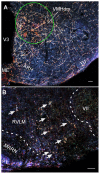Central urocortin 3 and type 2 corticotropin-releasing factor receptor in the regulation of energy homeostasis: critical involvement of the ventromedial hypothalamus
- PMID: 23316185
- PMCID: PMC3539675
- DOI: 10.3389/fendo.2012.00180
Central urocortin 3 and type 2 corticotropin-releasing factor receptor in the regulation of energy homeostasis: critical involvement of the ventromedial hypothalamus
Abstract
The vital role of the corticotropin-releasing factor (CRF) peptide family in the brain in coordinating response to stress has been extensively documented. The effects of CRF are mediated by two G-protein-coupled receptors, type 1 and type 2 CRF receptors (CRF(1) and CRF(2)). While the functional role of CRF(1) in hormonal and behavioral adaptation to stress is well-known, the physiological significance of CRF(2) remains to be fully appreciated. Accumulating evidence has indicated that CRF(2) and its selective ligands including urocortin 3 (Ucn 3) are important molecular mediators in regulating energy balance. Ucn 3 is the latest addition of the CRF family of peptides and is highly selective for CRF(2). Recent studies have shown that central Ucn 3 is important in a number of homeostatic functions including suppression of feeding, regulation of blood glucose levels, and thermoregulation, thus reinforcing the functional role of central CRF(2) in metabolic regulation. The brain loci that mediate the central effects of Ucn 3 remain to be fully determined. Anatomical and functional evidence has suggested that the ventromedial hypothalamus (VMH), where CRF(2) is prominently expressed, appears to be instrumental in mediating the effects of Ucn 3 on energy balance, permitting Ucn 3-mediated modulation of feeding and glycemic control. Thus, the Ucn 3-VMH CRF(2) system is an important neural pathway in the regulation of energy homeostasis and potentially plays a critical role in energy adaptation in response to metabolic perturbations and stress to maintain energy balance.
Keywords: CRF; Ucn 3; VMH; energy balance; feeding; glucose.
Figures



References
-
- Bale T. L., Anderson K. R., Roberts A. J., Lee K. F., Nagy T. R., Vale W. (2003). Corticotropin-Releasing factor receptor-2-deficient mice display abnormal homeostatic responses to challenges of increased dietary fat and cold. Endocrinology 144 2580–2587 - PubMed
-
- Bale T. L., Contarino A., Smith G. W., Chan R. K. W., Gold L. H., Sawchenko P. E., et al. (2000). Mice deficient for corticotropin-releasing hormone receptor-2 display anxiety-like behavior and are hypersensitive to stress. Nat. Genet. 24 410–414 - PubMed
-
- Bale T. L., Vale W. W. (2004). CRF and CRF receptors: role in stress responsivity and other behaviors. Annu. Rev. Pharmacol. Toxicol. 44 525–557 - PubMed
Grants and funding
LinkOut - more resources
Full Text Sources
Other Literature Sources

